The effectiveness of anti-tank aircraft in World War II is taken for granted by most writers on the subject, offering a technophile orthodoxy that can be seamlessly woven together with accounts of later developments up to and including the Iraq wars.
Luftwaffe legend Hans-Ulrich Rudel claimed to have destroyed 519 Soviet tanks, most of them while piloting a cannon-armed Junkers Ju-87G Panzerknäcker, or “tankbuster.” Aleksandr Yefimov, said to have destroyed 126 German tanks while flying the Ilyushin Il-2 Sturmovik, was twice made a Hero of the Soviet Union. Tales of their exploits helped to firmly establish a positive image of anti-tank aviation in histories of the conflict. But that image has little relation to the realities of close air support during the war.
The French Armée de l’Air made limited use of armor-piercing 20mm ammunition for Morane-Saulnier MS.406 fighters engaged in ground strafing during the May-June 1940 campaign in France, but little is known about the results of those operations. At that early stage of the war, the only air force much interested in the use of cannon-armed airplanes against vehicles was the Soviet Voyenno-Vozdushnye Sily (VVS), which in response to favorable reports regarding ground strafing in the Spanish Civil War was developing the heavily armored Sturmovik (ground-attack) aircraft, equipped with two 23mm cannons. However, since the Red Army was then also developing the exceptionally well-protected KV-1 and T-34 tanks, against which 23mm ammunition would have been useless, it is questionable whether a specific anti-tank role was seriously considered.
In Britain, the Royal Air Force began thinking of specialist anti-tank aviation in the spring of 1941, after Erwin Rommel’s first successes in Libya. Air Chief Marshal Sir Charles Portal, the chief of air staff, wrote to Lord Beaverbrook, minister of aircraft production, on April 14, 1941: “If the Army cannot stop the German armored fighting vehicles, we must. I believe we may do this, especially in open country, by attacking their supply vehicles and the armored fighting vehicles themselves. For this we require armor piercing ammunition.”
Portal’s opinion was not shared by all his subordinates. “It is not the job of the Air Force to stop deployed tanks,” wrote Air Vice Marshal John Slessor. “That is the job of the anti-tank weapon on the ground, of the sapper with his tank-traps and mines, of our own tanks, and of the properly trained infantryman….The job of the air is to make it impossible for the tank to go on owing to shortage of fuel, food and ammunition.”
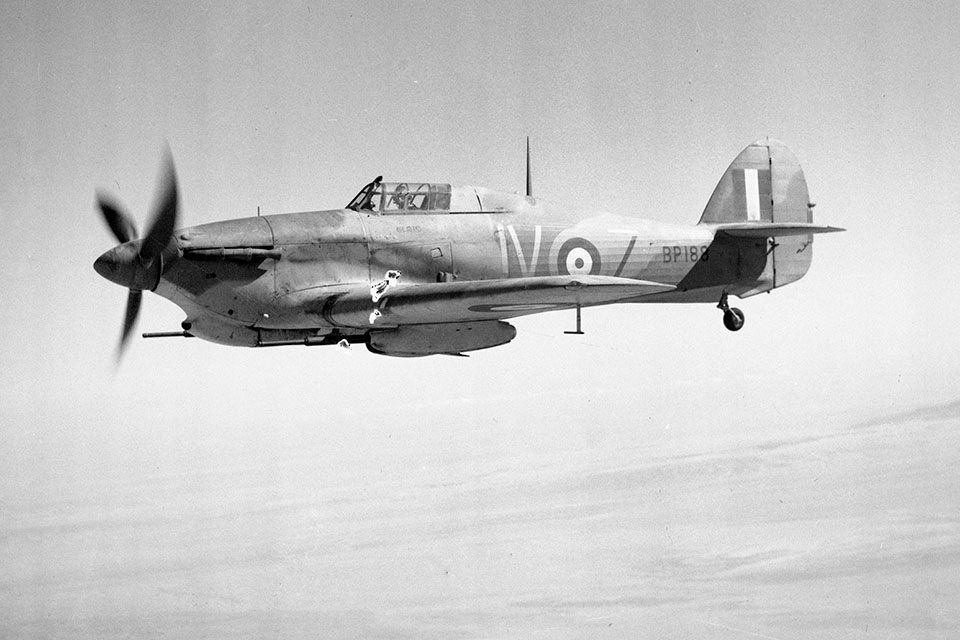
Nevertheless, the RAF was the first air force to field a dedicated anti-tank airplane, the Hawker Hurricane Mark IID, armed with two Vickers S 40mm cannons firing tungsten-tipped rounds. First in action at Bir Hakim in June 1942, No. 6 Squadron’s pilots quickly discovered one of the key disadvantages of going into combat with weaponry for which their aircraft were not specifically designed. On 6 Squadron’s second encounter with suitable ground targets, two German trucks were shot up (“one flamer”), but groundfire brought down one of the three attacking Hurricanes, the pilot escaping by parachute. Another had to make a forced landing. The bulky wing-mounted 40mm armament reduced the aircraft’s speed to 210 mph, making it very vulnerable to anti-aircraft fire and aerial interception. Later, the addition of 350 pounds of extra armor in the Hurricane IVD slowed the plane down even more.
Despite these difficulties, the anti-tank Hurricane seemed to do well at El Alamein: By October 1942, there were five Hurricane IID squadrons in North Africa, and the most proficient of these, the by-then veteran 6 Squadron, claimed 43 German tanks destroyed for the loss of nine aircraft by the end of that month. Thus, for October 26, the Squadron Operation Record Book announced (using Allied equivalents for Axis armor): “Another most successful operation, the Squadron being credited with two Honeys [light tanks], two Crusaders [medium tanks], one unidentified tank, five armored cars, one semi-tracked vehicle and one lorry. A very good show!” But a couple of weeks later, Advanced Air Headquarters Western Desert was complaining that there was now nothing for the Hurricane IIDs to shoot at—“the inherent weakness of a specialist force.”
There is no confirmation from the German side of the effectiveness of the Hurricane IID and IVD. The cannon mountings could be replaced by rails for rockets in a few hours, and during 1943 these planes were more often used, both in Italy and on the French coast, in rocket attacks. In Burma, they were supplied with 40mm explosive ammunition for use against “soft-skinned” targets because the Japanese had relatively few tanks. The whole design concept was, of course, no more than a stopgap. But it does seem that it was the potential of the rocket ammunition, rather than the 40mm cannon, that most impressed the RAF.
The Typhoon, Hawker’s intended fighter successor to the Hurricane, became the RAF’s choice to supersede the Hurricane IID and IVD in the ground-attack role. Seventy percent more powerful than the Hurricane IID and 50 percent heavier, the Typhoon was faster than fighter versions of the Hurricane II, even when carrying an underwing payload of eight rockets. By September 1944, the Second Tactical Air Force was operating no fewer than 20 squadrons of Typhoons for ground attack in northwest Europe, alongside 33 squadrons of fighters and 12 squadrons of twin-engine light bombers. Their finest hour came on August 7, 1944, when German armor counterattacked at Mortain, Normandy. In the course of 294 missions, 2,088 rockets were fired, 84 German tanks were claimed destroyed, 35 probably destroyed and 21 damaged. Wing Commander Charles Green of 121 Wing told his pilots that evening, “You know, chaps, this has been the day of the Typhoon and no bastard can take that away from us.”
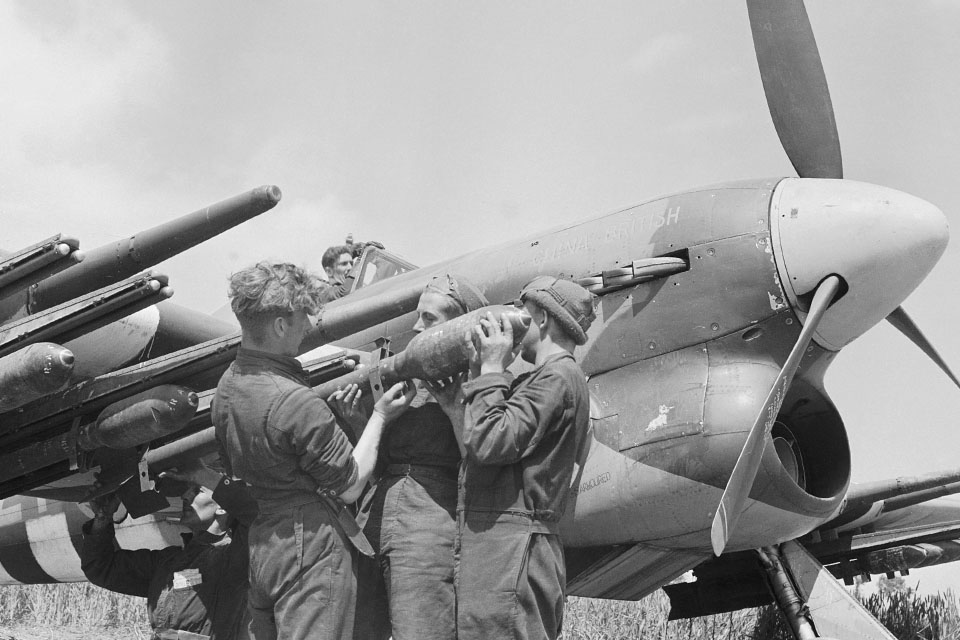
The Operations Record Book of No. 245 Squadron individually claimed the following results: (tanks) 15 flamers, seven smokers and four damaged; (armored fighting vehicles) four flamers, four smokers and three damaged. It also noted, “Today saw a major defeat of tank forces by rocket firing Typhoons in which this squadron played a leading part.”
Subsequent investigation of the battlefield by operational research teams, however, showed that of the 43 tanks and three self-propelled guns not removed by German recovery teams and left where they had been put out of action, only seven showed signs of having been hit by a rocket projectile. There is of course uncertainty about how many vehicles were removed by the Germans as they retreated, but it appears that seven of the unrecovered tanks were completely undamaged, suggesting that the recovery teams were not very thorough. Moreover, whereas the Typhoon pilots had claimed 54 unarmored vehicles destroyed and 58 probably destroyed or damaged, the operational research teams found only 30. Since a motor vehicle can be destroyed by machine-gun or mortar fire as well as by rockets, and would hardly be worth the trouble of recovering if hit by a rocket, it seems likely that the British pilots’ claims regarding unarmored vehicles destroyed were greatly exaggerated. This in turn casts doubts on their claims regarding tanks.
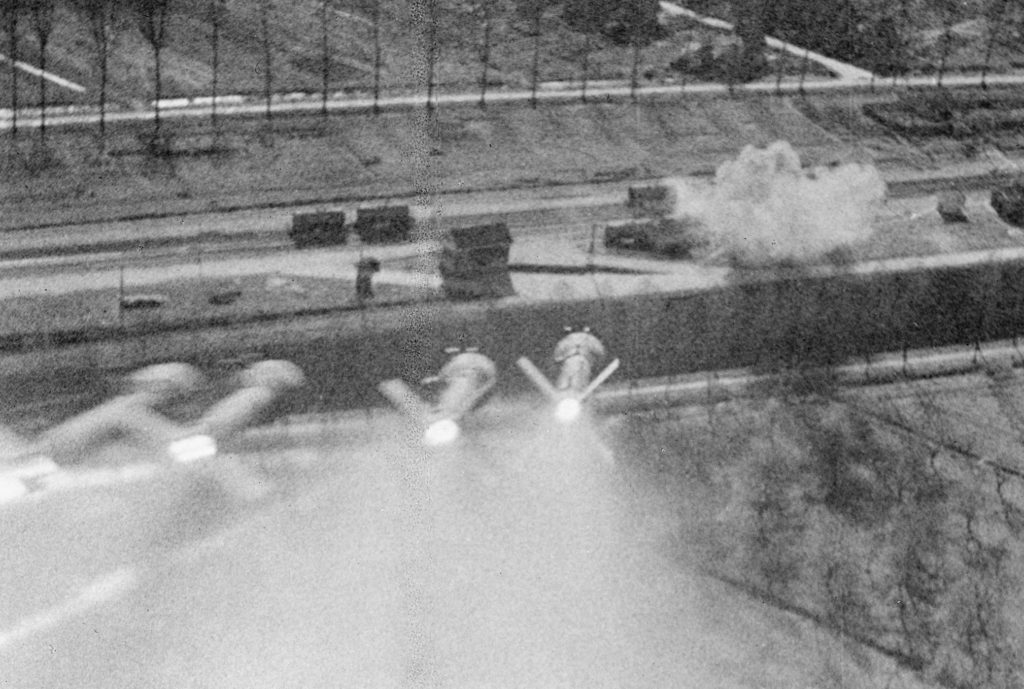
In reality, rockets were very difficult to aim and very inaccurate once launched. When fired, the rocket “dribbled” off its rail, dropped appreciably before it gained its maximum speed of more than 1,000 mph and began dropping again when it burned out after flying 500 yards under power. Coastal Command found that a 60-pound rocket launched at 600 yards from an aircraft flying at 250 mph in a 10-degree dive dropped 77 feet, as compared to a 20mm cannon shell that dropped 7½ feet. Whereas Coastal Command de Havilland Mosquitos attacked throttled back in a shallow dive, the Typhoons came down in a 60-degree dive—at about 400 mph. In the early days of the Normandy invasion they fired their rockets at about a thousand yards’ distance, but at Mortain it was supposed that it was more like a thousand feet. The steepness of the dive, and the fact that at a thousand-foot range the rocket would still be under power when it struck, reduced the amount of drop in the rocket’s trajectory. On the other hand, tanks are much smaller targets than the ships Coastal Command attacked, and the Typhoon pilots would only have had about five seconds to check their dive angle and aim.
No doubt some pilots could get the knack of it with a little practice, but one recalled, “The training, the practice, was nonexistent. I’d never fired a rocket till I went to Bognor, fired some rockets into the Channel twice and then I was back on ops.” German Tiger tank commander Otto Carius said, “Whenever I saw Typhoons I really was not worried. Their rockets only hit with luck.”
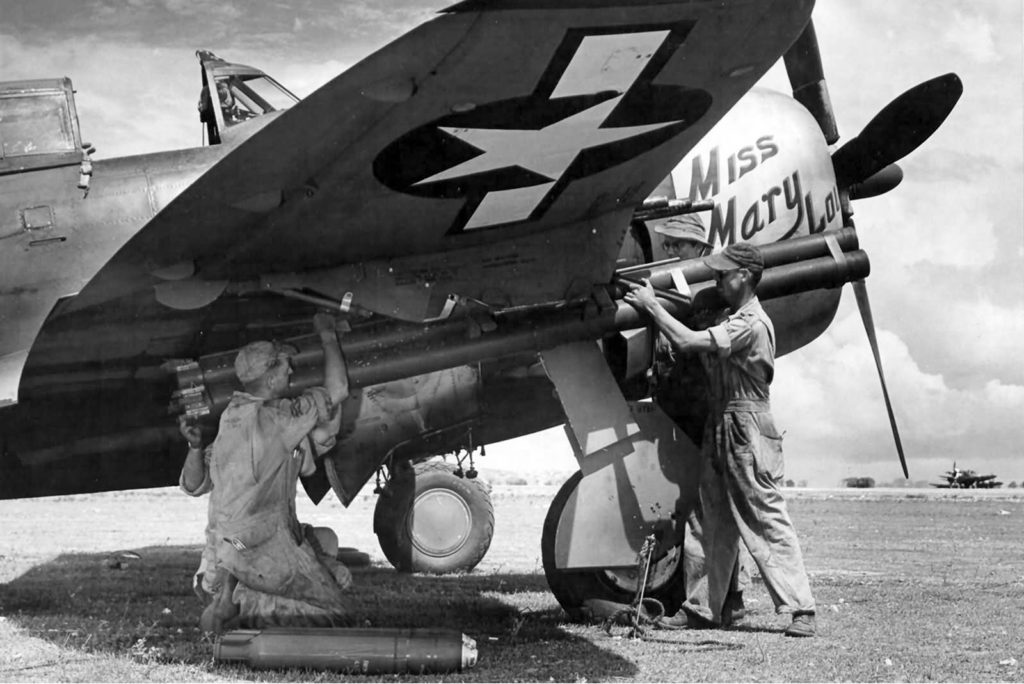
The Air Staff in London received a number of reports about the inaccuracy of rockets. Attacks on unarmored vehicles with bombs were claimed to be 60 percent more effective than attacks with rockets; attacks utilizing the Typhoon’s 20mm cannons as well as rockets were found to be only slightly more effective than attacks with cannons alone. The Air Staff persisted, nevertheless, in giving preference to rocket-armed Typhoons over bomb-armed ones.
U.S. Ninth Air Force units flying the Republic P-47 Thunderbolt were equipped with rockets in August 1944, but the experiment was abandoned after a few weeks, despite American pilots claiming a further 112 tanks and armored vehicles destroyed on August 7 (for a combined Allied total of 196, which was 19 more than the 177 tanks and self-propelled guns the Germans actually deployed, some of which were undoubtedly destroyed by ground forces). This was evidently not because American fliers lacked the over-optimism of their RAF counterparts: Some of them claimed to have knocked out German Tiger tanks simply by firing their .50-caliber machine guns at the road surface adjacent to the tank so that the rounds ricocheted up beneath the tank’s supposedly vulnerable underside. In fact, the Tiger had one-inch armored plate on its underside, which would barely have been scratched by a machine-gun bullet striking at an obtuse angle.
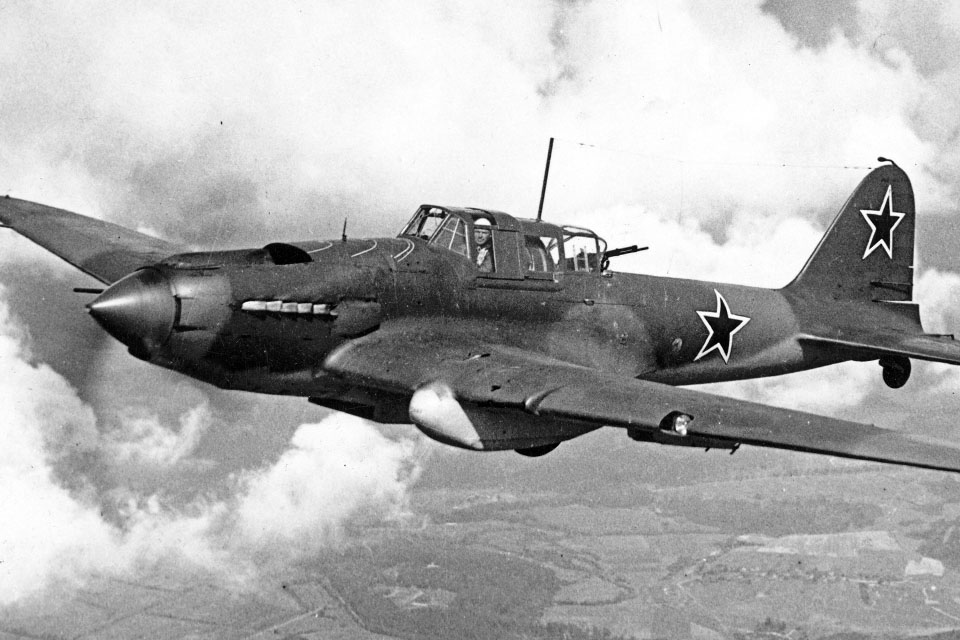
The VVS employed rockets too, though mainly against soft-skinned targets. But the Soviets also tried out a version of the Il-2 ground-attack aircraft that carried two 37mm Nudelman guns. Extraordinary results were claimed for 37mm-armed Il-2s at the 1943 Battle of Kursk, including knocking out 70 tanks from the 9th Panzer Division in only 20 minutes. German figures show that tank losses at Kursk were much fewer than the VVS claimed, however, and the Soviets ceased production of 37mm-armed Il-2s after 1943, suggesting that they thought it was rather a failure. Eight Soviet pilots claimed to have destroyed 63 or more German tanks on the Eastern Front, mainly while flying unmodified Il-2s. These claims are at odds with the considered verdict of German commanders: “Soviet leaders also lagged in producing anti-tank aircraft, presumably because they were slow in learning the procedures for attacking armored equipment. This failure permitted German tanks to operate in relative safety from air attacks throughout most of the war.”
That judgment is given additional weight by the attention the Germans gave to developing their own anti-tank aircraft. The Henschel Hs-129B-1/R2, a small, heavily armored single-seat twin with a 30mm gun, was introduced on the Eastern Front in late 1942. A handsome, strongly built airplane with unreliable French engines and the flying characteristics of a penguin, the Hs-129 was not popular with pilots. But at least two men, Rudolf-Heinz Ruffer and Hans-Hermann Steinkamp, claimed to have destroyed 70 or more Soviet tanks flying the type during the next two years.
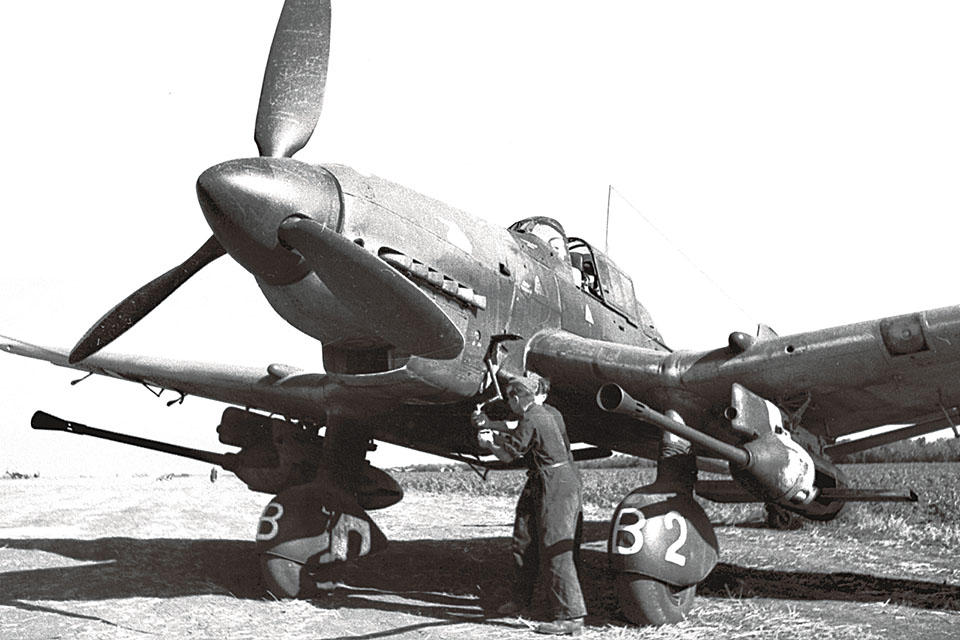
The Luftwaffe’s Ju-87G, mounting two 37mm guns, was technically a far inferior modification compared to the Soviet 37mm-armed Il-2. Its guns were housed in pods attached to a pylon under each wing—about three feet below the airplane’s center of gravity—and had 12 rounds in a clip projecting from the side of the breech, whereas the Il-2 had its guns in fairings close under the wings, with 50 rounds of ammunition per gun on a belt inside the wing. The Ju-87G’s pod-mounted guns not only affected its already poor speed and handling characteristics, but also jerked the nose of the aircraft down violently when fired. “Putting those cannon under the wings was like placing an elephant on roller skates,” said Stuka pilot Franz Kieslich. “The damned Stuka was already so slow our fighter escorts would weave and climb so as to not leave us….I hardly ever brought back an undamaged 87.”
Just over 200 Ju-87Gs were built. There were never more than five squadrons—fielding eight to 10 aircraft each—operating on Germany’s Eastern Front, with each squadron part of a regular ground-attack wing, representing about a tenth of its frontline strength.
Josef Blümel was credited with destroying 60 Soviet tanks from April to September 1944 while flying a Ju-87G; other pilots who were successful with the Panzerknäcker seem to have made more use of other Stuka variants. Hans-Ulrich Rudel, for example, is said to have fired off 5,000 rounds of 37mm ammunition in Ju-87Gs by June 1, 1944, as compared to 150,000 rounds of 20mm ammunition while flying a Ju-87D. Assuming he used up all his ammunition each time he encountered the enemy, this would suggest just over 200 engagements in Ju-87Gs and more than 400 in Ju-87Ds.
As is clear from the course of the fighting on the Eastern Front, the Germans never had enough Ju-87Gs to stop or even slow the overwhelming tide of Soviet armor. One reason the Luftwaffe did not produce more of the type—apart from the main problem of over-stretched resources—was that it was extremely difficult to fly effectively. While the 37mm cannon was far more accurate than rockets, the much smaller projectile could only penetrate the thinner part of a tank’s armor, i.e., the horizontal surfaces, especially the top of the turret and the armor above the tank’s engines. This meant that the pilot had to attack in a dive, preferably from directly behind to maximize the number of strikes above the engine, and pull out in the same split second as the recoil of the guns caused the plane to wobble in the air and jerk the nose downward. Inexperienced pilots found this almost impossible, and in many cases they did not survive long enough to learn the trick of it.
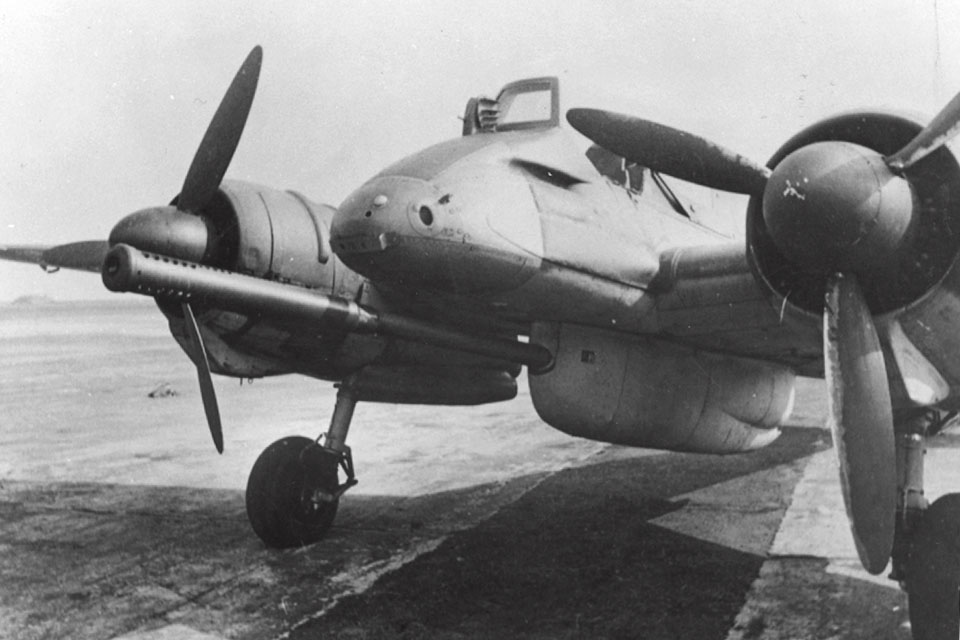
The Henschel Hs-129B-3 with a 75mm cannon, introduced in October 1944, was even more unmanageable. The weight and bulk of the gun made the aircraft difficult to handle, and the weapon’s recoil caused an instant deceleration of 10 mph. Some success was claimed with the Hs-129B-3, though the reduced charge that had to be used in each round produced only three-quarters of the muzzle velocity of the same gun when fitted in a tank. At any rate, only about 25 of these would-be giant killers were ever built.
Even leaving the question of numbers aside, the anti-tank airplane, whether it was a Typhoon with rockets or a Hurricane IID or Ju-87G with guns, was simply too difficult to operate to be a really practicable weapon of mass warfare. This is not to say that these special-purpose aircraft were completely useless during WWII. Even in the case of an ineffective hit or near miss by an attacking aircraft, the crews of armored vehicles might be left shaken and disoriented. The sense that they were never safe, even when not in contact with enemy ground units, added to the stress and exhaustion of combat.
One additional aspect of battlefield close support is worth mentioning: the potential of weaponry capable of neutralizing enemy units at a particular tactical juncture. For example, the initial advance of the British XXX Corps at Arnhem in September 1944 was accompanied by Typhoon attacks that seem to have paralyzed German opposition. Two hundred and fifty German troops, many “trembling with fright,” were taken prisoner in the first hour, a self-propelled gun was found abandoned with its engine still running and an entire battery of 88mm flak guns was captured intact.
Unfortunately, neither the British nor the Americans usually managed to coordinate air and ground operations closely enough for troops to benefit from the immediate aftermath of an airstrike. In most instances, the enemy was given a respite in which to pull itself together, and to take account of how little physical damage the air attack had actually inflicted. It might even be that the theoretical possibility of completely destroying a tank from the air distracted attention from the tactical utility of merely shaking up the tank crew so thoroughly that they functioned well below par for the remainder of the battle.
A.D. Harvey taught at the Universities of Cambridge, Salerno, La Reunion and Leipzig before becoming a full-time writer. His books include Arnhem and Testament of War: Literature, Art and the First World War. Further reading: Junkers Ju 87 Stuka, by Manfred Griehl; Typhoon Attack: The Legendary British Fighter in Combat in World War II, by Norman Franks; and Strike From the Sky: The History of Battlefield Air Attack, 1911-1945, by Richard P. Hallion.
This feature originally appeared in the March 2019 issue of Aviation History. Subscribe here!

